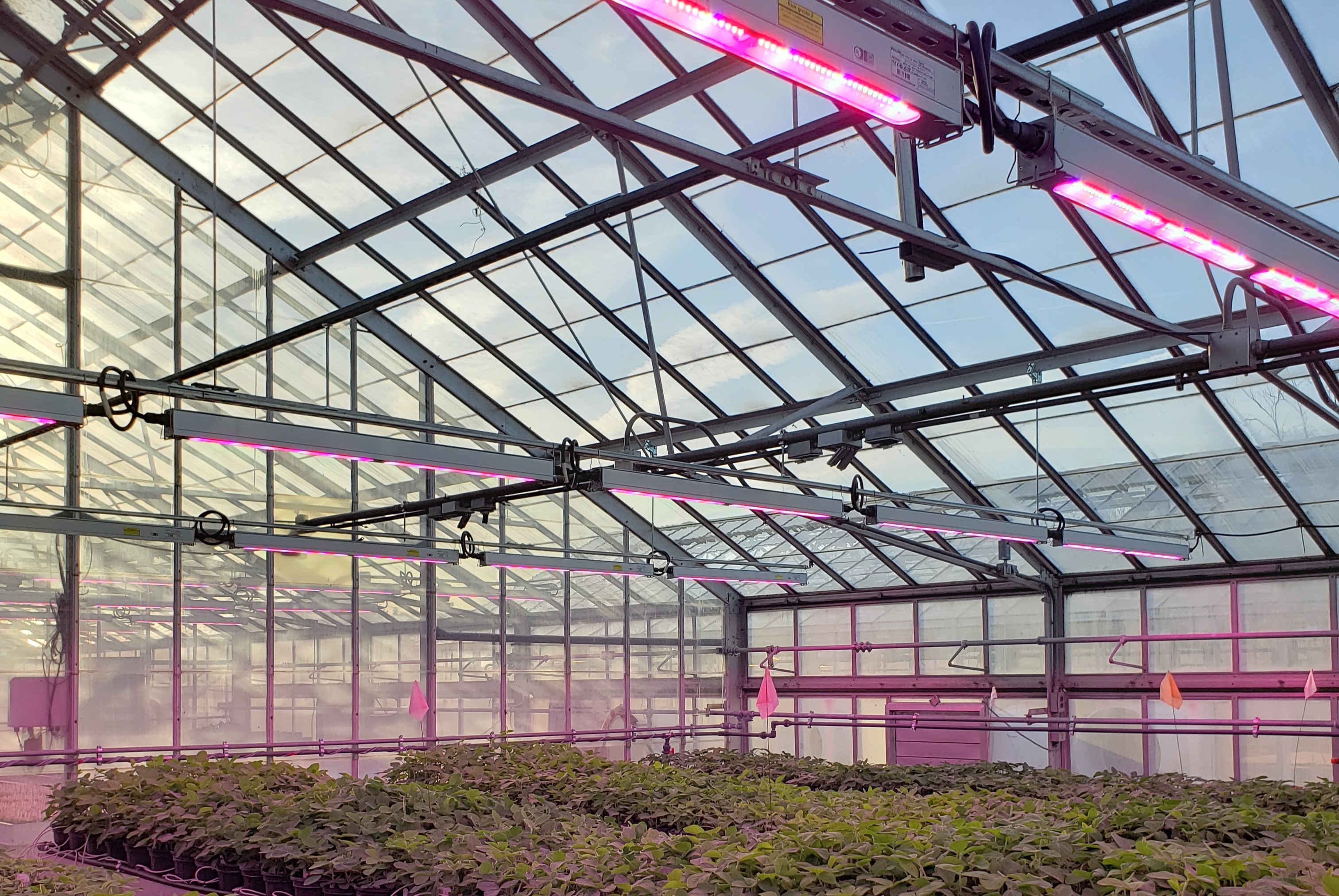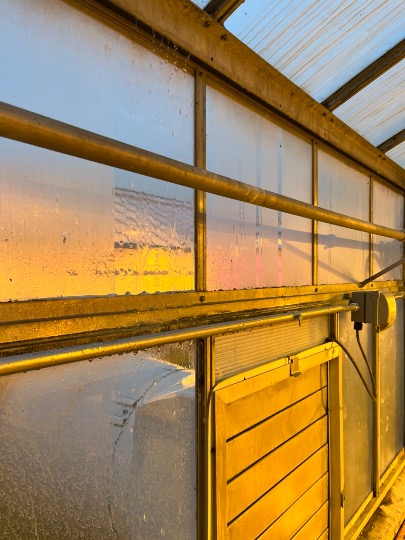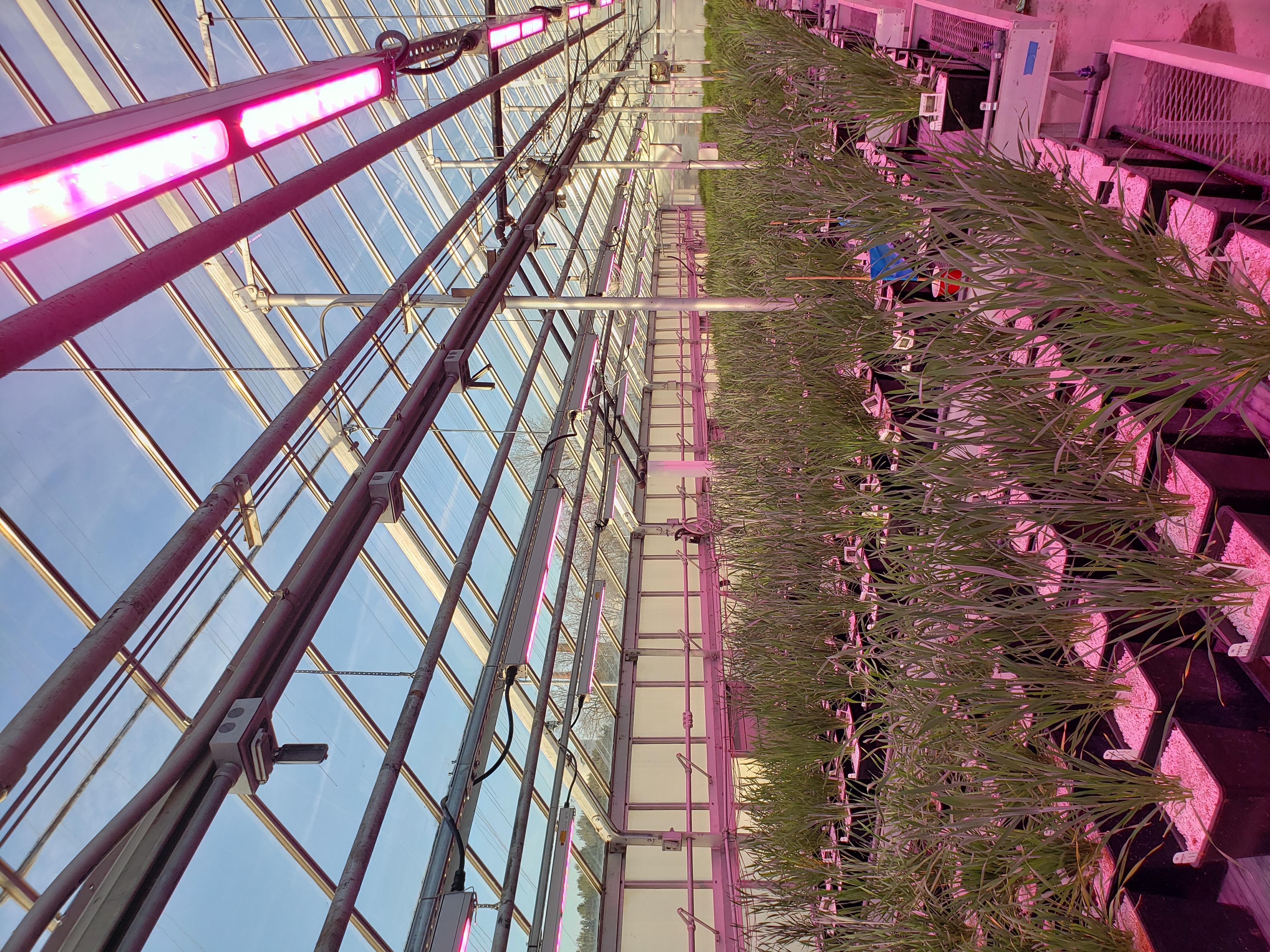MSU greenhouse renovations improving plant research
MSU-funded updates are ongoing, while State of Michigan-supported renovations begin in spring
EAST LANSING, Mich. — Dec. 23-24, 2022, were bitterly cold days on the Michigan State University campus. The temperature never climbed higher than 19 degrees Fahrenheit, while the low plunged to 3 F.
While these frigid conditions aren’t entirely rare for Michigan winters, they were extremely problematic for MSU’s outdated research greenhouses. The old, thin glass shell of the facility — along with an overmatched heating system — simply couldn’t keep up.
 3x2.jpg)
In one greenhouse that is exposed to the outdoors on three sides, the temperature was set to 77 degrees during the day and 68 degrees at night. The overtaxed heating system ran nonstop at 100% capacity, yet the temperature inside was up to 15 degrees below the desired setting.
Chrislyn Particka, director of the Plant Science Research Greenhouse Facility, said this incident drove home the need for updated facilities. This was, however, a known issue.
Prior to this situation, several units on campus recognized the condition of the research greenhouses as an area of concern. In partnership with Particka, the team identified upgrade opportunities and committed financial resources.
The units were:
- College of Natural Science.
- Infrastructure Planning and Facilities.
- MSU AgBioResearch.
- Office of the Provost.
- Office of the Vice President for Research and Innovation.
- Plant Science Research Greenhouse User Committee.
“MSU is one of the premier plant research institutions in the world, and to continue at that level we need infrastructure that supports world-class research,” Particka said. “We can’t have situations like that where we can’t control the temperature much at all because it undermines the integrity of our research.”

Although it remains an ongoing process, one of the first orders of business has been to replace the old high-pressure sodium lighting with modern light-emitting diode (LED) fixtures. Additionally, the leaky glass panes are being swapped out for double-wall acrylic and fresh seals. The new acrylic has a much higher insulating capacity and the improved seals stop moisture from entering, all while reducing energy consumption.
Climate control has been lacking due to 1960s technology, and equipping greenhouses with new climate control systems prevents many of the challenges with overheating or cooling and delivers more precise research conditions.
After those renovations, the same greenhouse that couldn’t deal with freezing outdoor temperatures is now a success story. On Jan. 14, 2024, temperatures dropped as low as minus 4 F, and the heating system — which did not run at full capacity and even shut off for a brief period — kept the inside temperature at the 77-degree daytime and 68-degree nighttime thresholds.
“It’s definitely a start, and we’re really happy with that,” Particka said. “We’re looking forward to getting more of our facility into the modern era of greenhouse research and production.”
A future of ‘transformational research’ now possible
In July 2022, the Michigan Legislature passed a higher education funding budget that included $53 million to MSU for updates to the greenhouse and dairy facilities on campus.
The announcement was a boon to the renovations that were already occurring in the greenhouses, allowing for a suite of updates that weren’t previously possible.
“I can’t begin to express how much this means to MSU and even more importantly, how much the transformational research made possible by this infrastructure investment will benefit Michigan farmers, their futures and livelihoods,” said George Smith, director of MSU AgBioResearch. “It’s been a collaborative approach and one that we could never have endeavored on our own. Much appreciation is extended to the Michigan Legislature, commodity organizations, and our agricultural partners for assisting and providing support for these much-needed new research facilities, upgrades and improvements.”
Erik Runkle, a professor and MSU Extension specialist in the Department of Horticulture, leads a research team that explores controlled-environment growth of herbaceous specialty crops. As co-chair of the Greenhouse User Committee, he has worked closely with Particka and fellow co-chair Tom Sharkey, a University Distinguished Professor in the Department of Biochemistry and Molecular Biology, on upgrade planning. Runkle said that modernizing the greenhouses will change the way faculty can approach research.
“With 1960s technology, there’s so much that we have to consider,” he said. “The components of the greenhouses don’t talk to one another very well, so you often see heating and cooling elements running simultaneously. But with updated facilities, we can focus on our research and not have to worry so much about the conditions on a day-to-day basis.
.jpg)
“With the MSU funding, we’ve looked at a lot of improvements like lighting that don’t involve structural work, but the State of Michigan support has allowed us to think much bigger.”
Along with technology and energy-efficiency updates to about 5,000 square feet of greenhouse space, funding from the state will support the demolition of old greenhouses and construction of roughly 20,000 square feet of new greenhouses with updated features. In addition to modern technology, these upgrades include higher ceilings that allow for more growing space for taller plants. A new headhouse that serves as the hub of the facility will also be built.
One of the features of the new greenhouses Runkle pointed to is an energy curtain that can also double as a shade curtain. A special fabric that contains aluminum strips, the retractable curtain filters light into the greenhouse, which affects heating and cooling. The curtain is operated automatically by the climate control system.
Currently without energy curtains, a whitewash is applied to greenhouses in the spring to provide shading, but it’s labor-intensive, only moderately effective and not customizable.
A groundbreaking ceremony for the state-funded work will take place at 1 p.m. on Friday, April 12 at the greenhouses on Farm Lane, acknowledging the legislative support that will help to usher in a new era of plant science at MSU.
“These renovations are a great first step in our greenhouse modernizations,” said Kelly Millenbah, dean of the College of Agriculture and Natural Resources. “As we break ground on the work funded by the State of Michigan, we’re deeply grateful to the partners and friends who advocated for this investment. We will continue to develop funding sources for the next phases of this work.”
An enduring need
While much progress is being made, there is more work to be done in procuring the funding needed to completely update the facilities. Particka and Runkle said that the cost of renovation has increased since the creation of the original proposal years ago, necessitating concessions on what can be upgraded now.
Renovations to the Center for Integrated Plant Systems greenhouses finished in November 2023, which constitutes 23% of the square footage for the research greenhouses. Even after the state-funded new construction and overhauls are completed, 42% of the total square footage will remain untouched.
“It’s an ongoing issue to find the needed funding,” Particka said. “We are working with partners across the university and beyond to discuss potential funding opportunities, but there’s no question that a significant need remains.”
Runkle believes there’s an opportunity for partners throughout plant agriculture to join together for the benefit of the entire industry.
“Quite simply, we need additional funding to do more of what we’re doing now,” he said. “We don’t have the resources to upgrade the greenhouses entirely, and that will leave some of our scientists continuing to use severely outdated technology and deteriorating structures.
“Just as an example, some of the greenhouses leak so badly now that we can’t run irrigation or drought research because outside moisture gets into the facility. That’s unacceptable. Make no mistake, we are extremely thankful for the funding we’ve received thus far, but we’re not where we need to be to remain competitive on a national and global scale.”
Michigan State University AgBioResearch scientists discover dynamic solutions for food systems and the environment. More than 300 MSU faculty conduct leading-edge research on a variety of topics, from health and climate to agriculture and natural resources. Originally formed in 1888 as the Michigan Agricultural Experiment Station, MSU AgBioResearch oversees numerous on-campus research facilities, as well as 15 outlying centers throughout Michigan. To learn more, visit agbioresearch.msu.edu.



 Print
Print Email
Email




